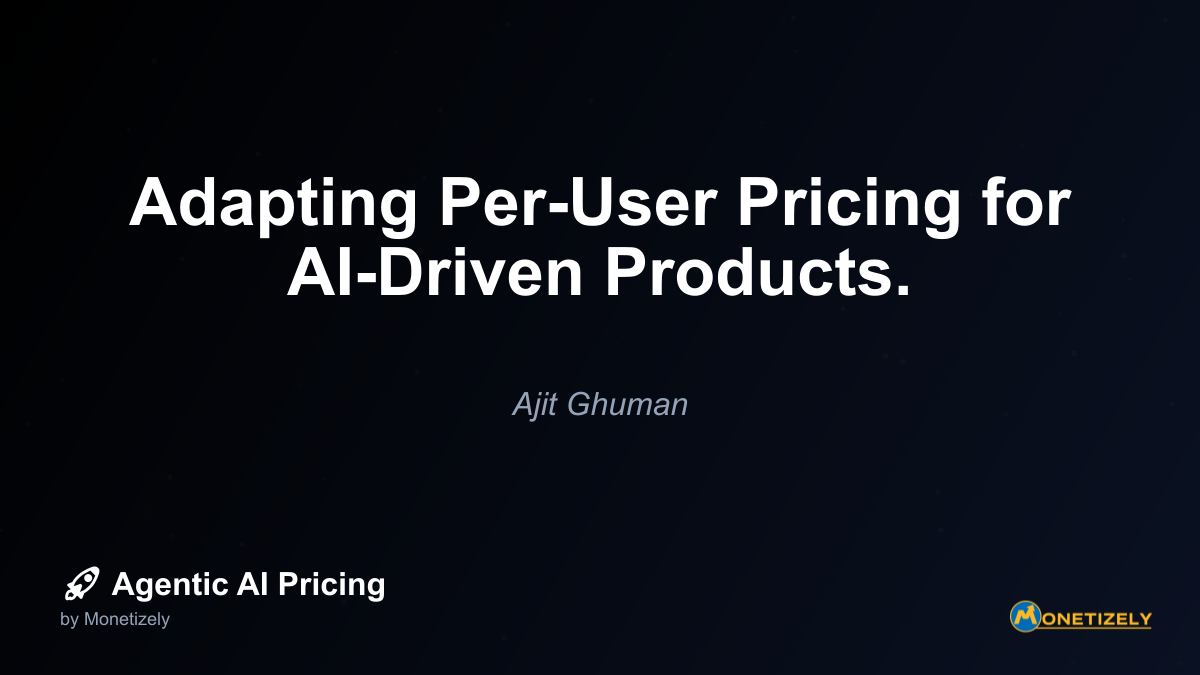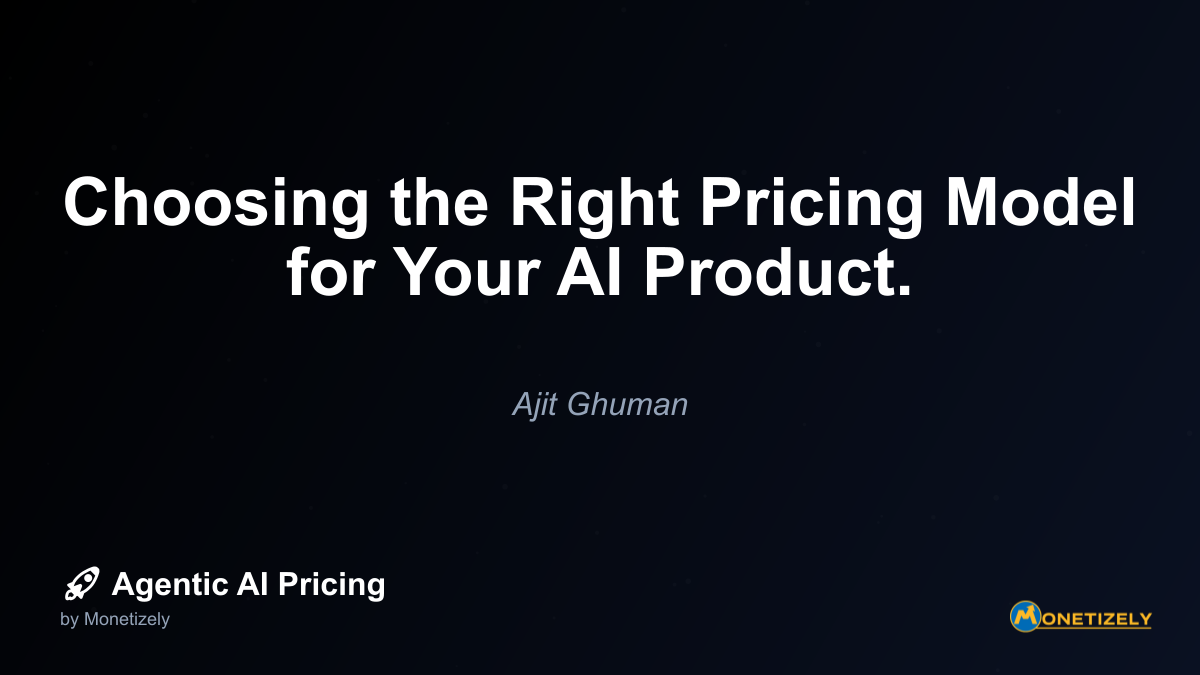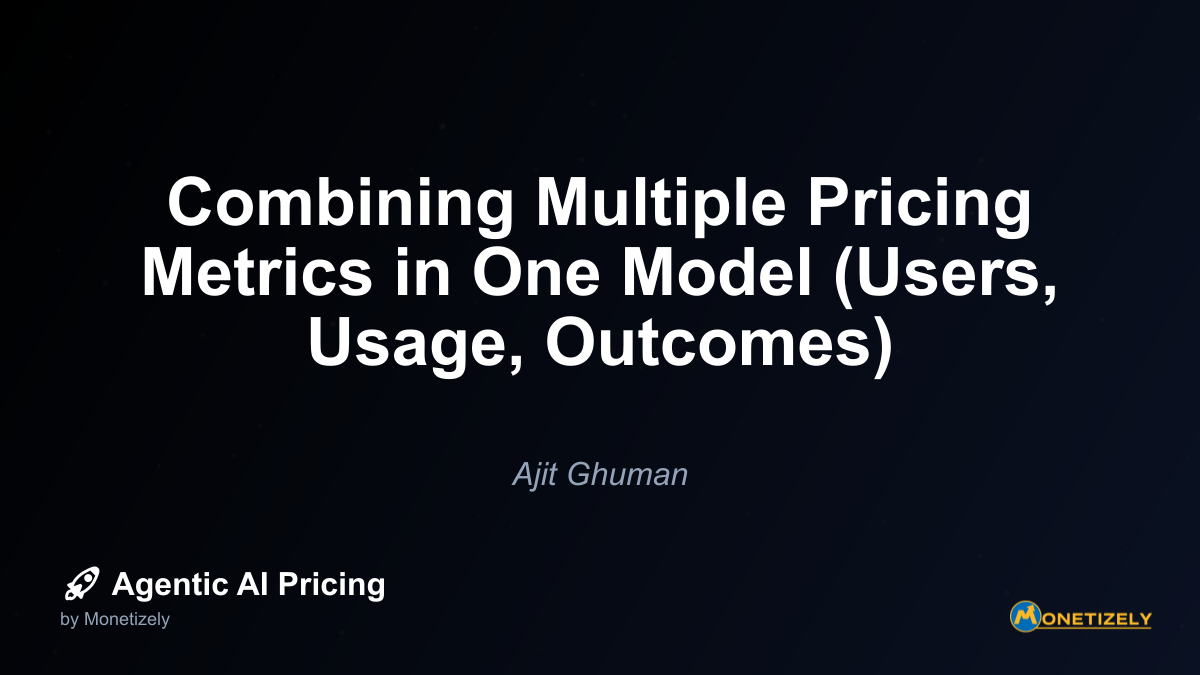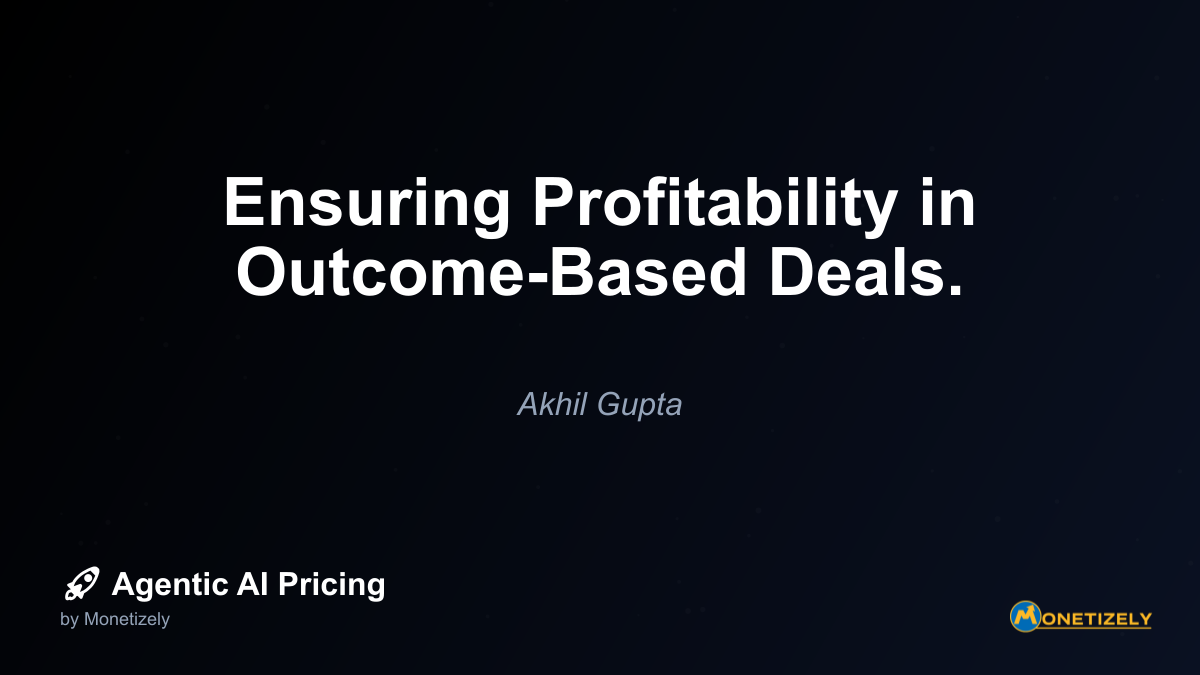· Ajit Ghuman · Agentic AI Pricing Strategies · 12 min read
Usage-Based Pricing (Per Activity): Pay-As-You-Go for AI Actions.
AI and SaaS Pricing Masterclass
Learn the art of strategic pricing directly from industry experts. Our comprehensive course provides frameworks and methodologies for optimizing your pricing strategy in the evolving AI landscape. Earn a professional certification that can be imported directly to your LinkedIn profile.
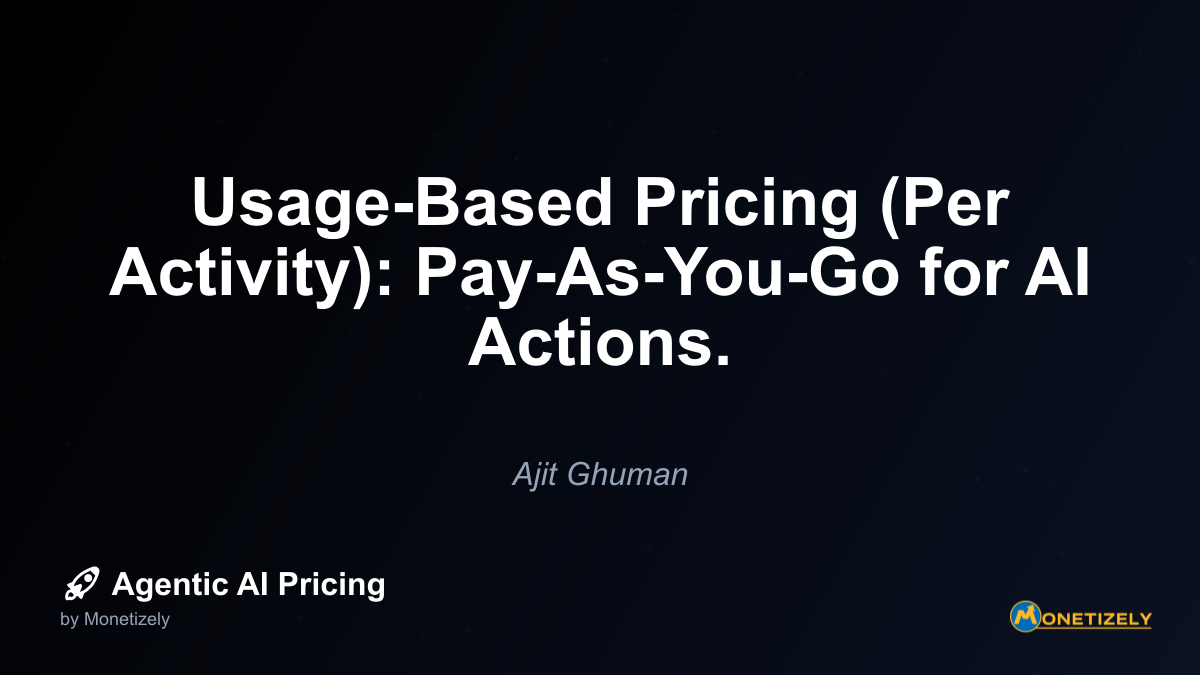
In today’s rapidly evolving AI landscape, businesses are constantly searching for pricing models that align costs with value. Usage-based pricing—often called pay-as-you-go or consumption-based pricing—has emerged as a compelling approach for AI agents, offering flexibility, scalability, and fairness. This model, where customers pay only for the AI actions or tasks they consume, represents a fundamental shift from traditional subscription models toward value-aligned monetization.
Understanding Usage-Based Pricing for AI Agents
Usage-based pricing for AI agents is a consumption model where customers pay based on the specific actions, tasks, or resources the AI consumes. Unlike flat-rate subscriptions, which charge a fixed monthly fee regardless of usage, this approach directly ties costs to actual consumption and value received.
The Core Mechanics of Usage-Based Pricing
At its heart, usage-based pricing for AI agents operates on a simple premise: customers pay only for what they use. This model measures consumption through various metrics:
- API calls: Charging per request to the AI service
- Tokens processed: Billing based on the volume of text processed (input) or generated (output)
- Compute time: Pricing based on the duration or intensity of computational resources used
- Tasks completed: Charging per specific action or outcome the AI agent accomplishes
- Transactions processed: Billing based on business-relevant interactions handled by the AI
According to research from Metronome, 78% of companies with usage-based pricing adopted it within the last five years, with nearly 50% implementing it in just the last two years—a clear acceleration driven by AI and cloud computing advancements.
The Evolution from Seats to Services
The traditional SaaS seat-based model (charging per user) is increasingly ill-suited for AI agents, which often perform tasks autonomously without direct human oversight. As BCG notes, “AI agents are disrupting conventional seat subscriptions, with 40% of IT buyers citing seat reduction as the main spending lever, facilitated by AI agents’ efficiency gains.”
This transition reflects a fundamental shift in how software delivers value. When AI agents replace human users, the pricing model must evolve accordingly to reflect the autonomous nature of these digital workers.
The Strategic Value Proposition of Usage-Based Pricing
Usage-based pricing offers compelling advantages for both providers and customers in the AI agent ecosystem.
Benefits for Customers
Cost aligned with actual value: Customers pay only for what they use, eliminating waste and ensuring costs directly reflect the value received.
Lower barriers to entry: Without large upfront commitments, businesses can adopt AI technologies with minimal initial investment, reducing financial risk.
Flexibility and scalability: Usage can scale up or down based on actual needs, supporting seasonal fluctuations or changing business requirements.
Transparency: Consumption-based pricing creates a clear connection between usage and cost, making it easier to attribute expenses to specific business functions or outcomes.
Experimentation opportunities: The pay-as-you-go model allows organizations to test different AI agent applications without significant financial commitment.
Benefits for Providers
Margin protection: As running large AI models incurs significant compute costs, usage-based pricing allows providers to maintain margins by passing through variable costs.
Expanded market reach: Lower entry barriers attract customers who might otherwise be unwilling to commit to substantial fixed fees.
Growth alignment: Revenue grows naturally with customer success and increased usage, creating a virtuous cycle.
Usage insights: Consumption data provides valuable insights into how customers use the product, informing product development.
Competitive differentiation: Flexible pricing can be a significant differentiator in crowded markets.
A Boston Consulting Group study found that 72% of enterprise decision-makers are more likely to adopt new AI technologies when offered consumption-based pricing options, highlighting the market demand for this approach.
Real-World Implementation Examples
Major AI providers have embraced various forms of usage-based pricing, each with unique approaches tailored to their specific services and customer needs.
OpenAI’s Token-Based Model
OpenAI, creator of GPT models and ChatGPT, employs a token-based pricing structure for its API services. Tokens represent chunks of text (roughly 4 characters in English), and customers are charged based on both input tokens (user prompts) and output tokens (AI-generated responses).
This approach directly ties costs to the complexity and length of interactions, with different models having different rates. For example:
- GPT-4 Turbo: $0.01/1K input tokens, $0.03/1K output tokens
- GPT-3.5 Turbo: $0.0015/1K input tokens, $0.002/1K output tokens
OpenAI also offers volume discounts for high-usage customers, creating a tiered consumption model that rewards scale.
Anthropic’s Claude API Pricing
Anthropic follows a similar token-based approach for its Claude models but structures its pricing differently:
- Claude 3 Opus: $15/million input tokens, $75/million output tokens
- Claude 3 Sonnet: $3/million input tokens, $15/million output tokens
- Claude 3 Haiku: $0.25/million input tokens, $1.25/million output tokens
This tiered approach allows customers to choose between more capable but expensive models and more affordable options based on their specific needs.
Microsoft Azure AI Services
Microsoft Azure offers a hybrid approach for its AI services, combining subscription components with usage-based elements:
- Azure OpenAI Service: Similar token-based pricing as OpenAI but integrated with Azure’s broader ecosystem
- Azure Cognitive Services: Pay-per-call API pricing with tiered volume discounts
- Azure AI Studio: Workspace-based subscriptions with usage-based compute charges
Microsoft’s approach demonstrates how usage-based elements can be integrated into broader platform offerings.
Salesforce’s Conversation-Based Pricing
Salesforce has adopted a conversation-based pricing model for its AI offerings, charging approximately $2 per AI conversation. This approach aligns well with customer service use cases where each interaction has clear business value.
As CEO Marc Benioff highlighted, “AI agents are fundamentally consumption products,” reflecting the shift toward measuring value through usage rather than seats.
Intercom’s Outcome-Based Approach
Intercom charges $0.99 per resolution for its AI customer service agent, focusing on outcomes rather than raw usage. This model directly ties costs to successful issue resolutions, creating clear alignment between price and business value.
Implementation Challenges and Solutions
While usage-based pricing offers significant advantages, implementing it effectively for AI agents presents several challenges that organizations must address.
Challenge: Cost Predictability
One of the most significant concerns with usage-based pricing is the potential for unpredictable costs. Customers may struggle to budget when bills can fluctuate based on usage.
Solutions:
Hybrid pricing models: Combining a base subscription with usage components creates a more predictable cost structure while maintaining flexibility. Research shows hybrid models can increase customer lifetime value by approximately 18% compared to pure consumption models.
Usage caps and alerts: Implementing maximum usage thresholds and proactive alerts helps prevent unexpected bills.
Predictive analytics: Providing tools that forecast future usage based on historical patterns helps customers budget more effectively.
Budget controls: Allowing customers to set spending limits ensures costs never exceed predetermined thresholds.
Challenge: Defining the Right Usage Metrics
Selecting appropriate usage metrics that align with both customer value and provider costs is crucial but complex.
Solutions:
Value-based metrics: Choose metrics that directly correlate with the value customers receive, not just provider costs.
Customer research: Conduct extensive customer interviews to understand how they perceive value from AI agents.
Metric experimentation: Test different metrics with select customers to determine which best aligns with perceived value.
Outcome focus: Where possible, tie metrics to business outcomes rather than technical measures.
Challenge: Technical Implementation
Building the infrastructure to track, measure, and bill for usage accurately requires significant technical investment.
Solutions:
Specialized billing platforms: Utilize platforms designed for usage-based billing, such as Stripe Billing, Chargebee, or specialized solutions like Orb.
Real-time usage tracking: Implement robust systems for monitoring and reporting usage in real-time.
API-first architecture: Design systems with metering and tracking built in from the ground up.
Integration with analytics: Connect usage data with business intelligence tools to derive actionable insights.
Challenge: Customer Education
Many customers are unfamiliar with usage-based pricing models and may struggle to understand how their actions affect costs.
Solutions:
Transparent dashboards: Provide clear, real-time visibility into current usage and projected costs.
Usage simulators: Offer tools that allow customers to estimate costs based on anticipated usage patterns.
Best practice guides: Create resources that help customers optimize their usage of AI agents.
Dedicated customer success: Assign specialists to help customers understand and manage their consumption.
Best Practices for Implementing Usage-Based Pricing
To successfully implement usage-based pricing for AI agents, organizations should follow these strategic best practices:
1. Align Pricing with Customer Value
The most effective usage-based pricing models directly connect costs with the value customers receive. This requires:
- Extensive customer research to understand how and when value is created
- Regular feedback loops to refine the value-price alignment
- Willingness to evolve metrics as customer needs and perceptions change
2. Provide Transparent Cost Visibility
Customers need clear visibility into their usage and associated costs:
- Real-time dashboards showing current usage and projected costs
- Detailed invoices that break down consumption by relevant dimensions
- Historical usage data to identify patterns and optimize consumption
- Usage alerts when approaching predetermined thresholds
MongoDB Atlas exemplifies this approach with its comprehensive usage reporting and predictive cost estimation tools.
3. Implement Flexible Pricing Structures
Different customers have different needs and preferences:
- Offer multiple pricing tiers with volume discounts
- Provide hybrid options combining fixed and variable components
- Allow customers to choose between different consumption models
- Create specialized pricing for enterprise customers with unique requirements
4. Establish Fair Usage Policies
Protect both customers and infrastructure:
- Implement rate limiting to prevent abuse
- Set reasonable usage quotas based on customer tier
- Detect anomalous usage patterns that might indicate issues
- Create clear policies for handling excessive usage
5. Build Robust Tracking and Billing Infrastructure
The technical foundation must support accurate metering and billing:
- Invest in reliable usage tracking systems
- Implement automated billing processes
- Ensure data accuracy through regular audits
- Design systems with scalability in mind
6. Create Customer Success Programs
Help customers succeed with the pricing model:
- Provide education about optimizing usage
- Offer consultation services for high-value customers
- Create communities for sharing best practices
- Regularly review usage patterns to identify optimization opportunities
The Future of Usage-Based Pricing for AI Agents
As the AI agent ecosystem continues to evolve, several trends are emerging that will shape the future of usage-based pricing:
Hybrid Models Becoming the Standard
Pure usage-based pricing is increasingly giving way to hybrid models that combine fixed and variable components. This approach balances predictability with flexibility, addressing the primary concern of consumption-based pricing while maintaining its benefits.
According to Zuora’s research, companies implementing hybrid pricing models see approximately 18% higher customer lifetime value compared to those using pure consumption models.
Outcome-Based Pricing Evolution
The market is gradually shifting from charging for inputs (API calls, tokens) to charging for outcomes (successful transactions, problems solved). This evolution more directly ties pricing to business value, creating stronger alignment between vendors and customers.
Intercom’s approach of charging per resolved conversation exemplifies this trend, focusing on the business outcome rather than the technical resources consumed.
AI-Powered Pricing Optimization
Ironically, AI itself is becoming a key tool for optimizing usage-based pricing models. Advanced analytics and machine learning allow companies to:
- Predict customer usage patterns with greater accuracy
- Identify optimal pricing tiers and thresholds
- Detect potential churn risks based on usage changes
- Recommend personalized pricing structures for different customer segments
Enhanced Cost Control Mechanisms
As usage-based pricing matures, more sophisticated cost control mechanisms are emerging:
- Predictive budget alerts based on usage trends
- Automated scaling of resources based on budget constraints
- Dynamic rate limiting that adjusts based on consumption patterns
- AI-powered usage optimization recommendations
Increased Standardization
The industry is moving toward more standardized approaches to usage-based pricing:
- Common metrics across similar services
- Standardized billing formats and reporting structures
- Shared best practices for implementation
- Industry benchmarks for pricing and consumption
Measuring Success: Key Metrics for Usage-Based Pricing
Evaluating the effectiveness of usage-based pricing requires tracking specific metrics that reflect both customer success and business outcomes:
Customer-Focused Metrics
Customer Lifetime Value (CLV): Measure how usage-based pricing affects the long-term value of customer relationships.
Churn Rate: Track whether the pricing model improves retention by aligning costs with value.
Customer Satisfaction: Monitor satisfaction specifically related to pricing and billing transparency.
Time to Value: Assess how quickly customers achieve meaningful outcomes with the AI agent.
Usage Growth Rate: Measure the pace at which customers increase their consumption over time.
Business Performance Metrics
Average Revenue Per User (ARPU): Track how usage-based pricing affects per-customer revenue.
Gross Margin: Monitor how effectively the pricing model covers variable costs while maintaining profitability.
Customer Acquisition Cost (CAC): Assess whether the pricing model reduces barriers to adoption and lowers acquisition costs.
Revenue Mix: Analyze the balance between fixed subscription revenue and variable usage revenue.
Unit Economics: Measure cost and revenue per API call, compute minute, or other relevant usage unit.
Operational Metrics
Billing Accuracy: Track errors or disputes related to usage measurement and billing.
Rate Limit Triggers: Monitor how often customers hit usage limits or thresholds.
Usage Pattern Predictability: Assess how consistent customer usage patterns are over time.
Support Tickets Related to Billing: Measure customer confusion or issues with the pricing model.
Infrastructure Utilization: Track how effectively resources are being used to support customer demand.
Case Study: Snowflake’s Usage-Based Success
Snowflake provides one of the most successful examples of usage-based pricing in the data and AI ecosystem. While not strictly an AI agent provider, their approach offers valuable lessons applicable to AI pricing.
Approach
Snowflake implemented a credit-based consumption model where customers pay for:
- Storage: Based on the amount of data stored
- Compute: Based on the processing power used for queries and operations
- Data Transfer: Based on the volume of data moved between regions or services
Customers purchase Snowflake credits, which are then consumed based on actual usage. Different operations consume different amounts of credits, creating a flexible system that scales with customer needs.
Results
This usage-based approach has driven remarkable business results:
- Revenue growth from $97 million in 2019 to over $1.2 billion in 2022
- Net revenue retention rate consistently above 170%
- Rapid customer adoption across industries
- Successful IPO and continued market leadership
Key Lessons
Snowflake’s success highlights several important principles for usage-based pricing:
- Transparent consumption: Customers have clear visibility into how credits are consumed
- Resource alignment: Pricing directly reflects the resources used
- Scalability: The model works for both small startups and large enterprises
- Value correlation: Credit consumption aligns with the business value received
Comparing Usage-Based Pricing to Alternative Models
To fully understand the strategic position of usage-based pricing, it’s valuable to compare it with alternative pricing approaches for AI agents:
Usage-Based vs. Subscription Pricing
Subscription Pricing:
- Fixed recurring fee regardless of actual usage
- Predictable costs for customers and revenue for providers
- Simple to understand and budget for
- May lead to underutilization or “shelf-ware”
Usage-Based Pricing:
- Variable costs based on actual consumption
- Direct alignment between cost and value
- More efficient resource allocation
- Potential for unpredictable costs
Best For: Usage-based pricing works best when consumption varies significantly between customers or over time, while subscription models are preferable when usage is consistent and predictable.
Usage-Based vs. Outcome-Based Pricing
Outcome-Based Pricing:
- Charges based on specific business results achieved
- Perfect theoretical alignment with value
- Difficult to implement and measure accurately
- Requires agreement on outcome definitions and attribution
Usage-Based Pricing:
- Charges based on resource consumption or activities
- Easier to measure and implement
- Less perfect alignment with business value
- More predictable for providers
Best For: Outcome-based pricing works best when outcomes are clearly defined and measurable, while usage-based models are more appropriate when the connection between usage and outcomes is less direct or harder to measure.
Usage-Based vs. Tiered Pricing
Tiered Pricing:
- Predefined packages with different feature sets and capacities
- Simplifies customer decision-making
- Creates artificial boundaries between tiers
- May lead to customers paying for unused capacity
Usage-Based Pricing:
- Continuous scaling based on actual consumption
- No artificial tier boundaries
- More complex decision-making for customers
- Precise alignment between usage and cost
Best For: Tiered pricing works well when customers prefer simplicity and predictability, while usage-based models excel when customers want maximum flexibility and precise cost alignment.
Co-Founder & CEO
Ajit is the author of Price To Scale, a top book on SaaS Pricing and is the Founder of Monetizely. Ajit has led and worked in pricing and product marketing at firms like Twilio, Narvar and Medallia. His work has been featured in Forbes and VentureBeat. Ajit regularly consults with software companies from Seed stage to post-IPO on pricing strategy. Ajit is also a highly-rated co-instructor for 'The Art of SaaS Pricing and Monetization' on Maven.
Pricing Strategy Audit
Let our experts analyze your current pricing strategy and identify opportunities for improvement. Our data-driven assessment will help you unlock untapped revenue potential and optimize your AI pricing approach.

